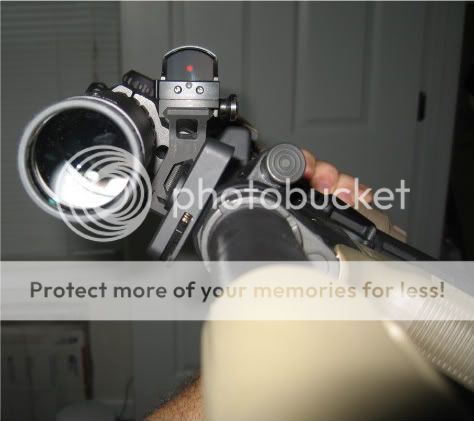Tgace
Grandmaster
- Joined
- Jul 31, 2003
- Messages
- 7,766
- Reaction score
- 409
when things go sideways the things worth believing in
This post is going to try and explain one of the more difficult combat carbine concepts to comprehend (see what I did there ?). That is the trajectory of a rifle round when firing from the "rollover" or "urban" prone position.
Before I try this, you need to review what the normal trajectory of a fired round is:

While the common phrase used when talking about a bullets flight is that a round "rises to the line of sight" after it exits the muzzle, the fact is the law of physics cannot be denied. Like water from a hose, gravity takes hold of a bullet the moment it exits the barrel.
If the bore line and your line of sight were the same, a bullets trajectory would look something like this:


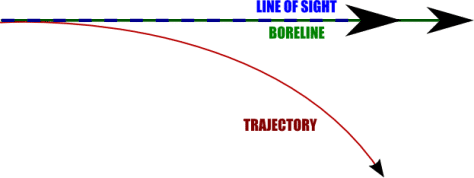
So...your weapons sighting system is designed so that the barrel angles upwards in relation to your line of sight.

When the round exits the barrel gravity still takes immediate effect, but because of the upward angle of the barrel the bullet follows a curved trajectory.
When the rifle is held in this upright position, bullets will impact a target in more or less a vertical string depending on the distance to the target. Wind can impact the strike laterally but that's for another discussion. Within the average engagement envelope of a combat carbine wind is not typically a major concern.
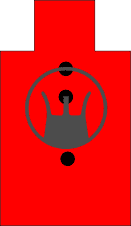
This whole relationship changes when the rifle is canted or held sideways. One of the common positions in modern combat carbine application is the "rollover" or "urban" prone position.
[youtube=[MEDIA=youtube]1_OhYvhSD6o[/MEDIA]
To maximize cover and concealment, it may become necessary to hold your rifle on it's side.
This is when trying to explain things becomes dicey, and if not explained well can leave the student scratching his/her head.
To start with remember these things.
Normally the barrel points up and away from the ground:

On it's side the barrel is more or less parallel to the ground. Seen from above, an M4 with it's ejection port up would have a sight/bore/trajectory relationship somewhat like this:

Seen from the side the bullets drop would look more like this:

Not an "arch" but an immediate pull to the ground by gravity.
With the velocities involved this pull isn't extremely "drastic" at shorter ranges (and you are not a surgical sniper). A rifle with a 50/200 zero will be about .5 to .75 inches "low" at 50 yards... 2 to 2.5 inches low at 100. BUT the differences will be drastic the further out you go. 4-5 inches low at 150 yards and at 200 yards you are looking at being 8-9 inches low. Remember, on its side the bullet is constantly being pulled down...no "arch".
Because the barrel is pointed left or right in relation to what side you are laying on, the bullet will continue in that direction till it strikes the ground. A stringing of strikes on target will be similar to this (not mathematically accurate...more as an example):
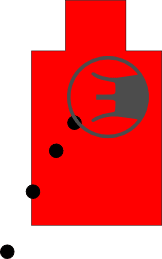
Remember how at CQB ranges there can be a "sight over bore" issue? A head shot at room distance must be aimed at the hairline to strike in the "sunglasses zone". This is due to the fact that the sights are above the barrel, and the angle of the barrel wont intersect the sight line till it reaches "close zero" which can be 50 yards away. In normal orientation, the rule of thumb is to aim about 2-2.5 inches high for surgical shots from 0-25 yards.
In sideways orientation, the round will NEVER be above your sight line, but left or right of it. The bullet will be striking on the "magazine side" of your weapon at short range by about the same distance as it would have been below your sights in upright orientation.
If you are in rollover prone, ejection port up, and trying to hit a BG between the eyes at 10 yards you will be 2-2.5 inches right (with a 50/200 zero). So at CQB ranges at narrow targets like headshots or knees from under a vehicle it's... "Aim AWAY from the magazine".
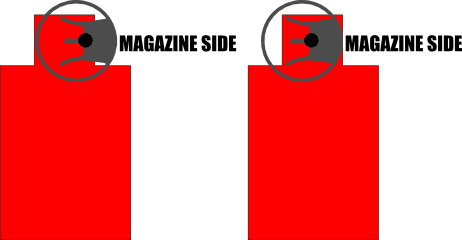
For more general combative applications however (read..COM hits under most circumstances), the rule of thumb to remember when shooting rollover is "Aim High and to the Magazine Side".
From 0 to about 75 yards just hold high on the center of the torso.

From 75 to about 150 hold high and to the magazine side around the targets pectoral.

From 150 to 200 hold high and to the magazine side on the targets shoulder

This will get you COM hits only needing to remember three holdovers; 0-75, over 75, and over 150.
There...that's the best I can do. Please let me know if you are confused or if I can clarify anything for you.
This post is going to try and explain one of the more difficult combat carbine concepts to comprehend (see what I did there ?). That is the trajectory of a rifle round when firing from the "rollover" or "urban" prone position.
Before I try this, you need to review what the normal trajectory of a fired round is:

While the common phrase used when talking about a bullets flight is that a round "rises to the line of sight" after it exits the muzzle, the fact is the law of physics cannot be denied. Like water from a hose, gravity takes hold of a bullet the moment it exits the barrel.
If the bore line and your line of sight were the same, a bullets trajectory would look something like this:



So...your weapons sighting system is designed so that the barrel angles upwards in relation to your line of sight.

When the round exits the barrel gravity still takes immediate effect, but because of the upward angle of the barrel the bullet follows a curved trajectory.
When the rifle is held in this upright position, bullets will impact a target in more or less a vertical string depending on the distance to the target. Wind can impact the strike laterally but that's for another discussion. Within the average engagement envelope of a combat carbine wind is not typically a major concern.

This whole relationship changes when the rifle is canted or held sideways. One of the common positions in modern combat carbine application is the "rollover" or "urban" prone position.
[youtube=[MEDIA=youtube]1_OhYvhSD6o[/MEDIA]
To maximize cover and concealment, it may become necessary to hold your rifle on it's side.
This is when trying to explain things becomes dicey, and if not explained well can leave the student scratching his/her head.
To start with remember these things.
- The relationship of the boreline to the weapons sights remains the same. The barrel still angles "towards the sights".
- The bullets trajectory is no longer an arch. Because the barrel is no longer pointed "UP", but to the left or right, the bullet exits the muzzle and starts to immediately drop.
- There is no longer an "up and down" stringing of rounds on the target. Bullets will be low and to one side or the other dependent on which side the gun is on.
Normally the barrel points up and away from the ground:

On it's side the barrel is more or less parallel to the ground. Seen from above, an M4 with it's ejection port up would have a sight/bore/trajectory relationship somewhat like this:

Seen from the side the bullets drop would look more like this:

Not an "arch" but an immediate pull to the ground by gravity.
With the velocities involved this pull isn't extremely "drastic" at shorter ranges (and you are not a surgical sniper). A rifle with a 50/200 zero will be about .5 to .75 inches "low" at 50 yards... 2 to 2.5 inches low at 100. BUT the differences will be drastic the further out you go. 4-5 inches low at 150 yards and at 200 yards you are looking at being 8-9 inches low. Remember, on its side the bullet is constantly being pulled down...no "arch".
Because the barrel is pointed left or right in relation to what side you are laying on, the bullet will continue in that direction till it strikes the ground. A stringing of strikes on target will be similar to this (not mathematically accurate...more as an example):

Remember how at CQB ranges there can be a "sight over bore" issue? A head shot at room distance must be aimed at the hairline to strike in the "sunglasses zone". This is due to the fact that the sights are above the barrel, and the angle of the barrel wont intersect the sight line till it reaches "close zero" which can be 50 yards away. In normal orientation, the rule of thumb is to aim about 2-2.5 inches high for surgical shots from 0-25 yards.
In sideways orientation, the round will NEVER be above your sight line, but left or right of it. The bullet will be striking on the "magazine side" of your weapon at short range by about the same distance as it would have been below your sights in upright orientation.
If you are in rollover prone, ejection port up, and trying to hit a BG between the eyes at 10 yards you will be 2-2.5 inches right (with a 50/200 zero). So at CQB ranges at narrow targets like headshots or knees from under a vehicle it's... "Aim AWAY from the magazine".

For more general combative applications however (read..COM hits under most circumstances), the rule of thumb to remember when shooting rollover is "Aim High and to the Magazine Side".
From 0 to about 75 yards just hold high on the center of the torso.

From 75 to about 150 hold high and to the magazine side around the targets pectoral.

From 150 to 200 hold high and to the magazine side on the targets shoulder

This will get you COM hits only needing to remember three holdovers; 0-75, over 75, and over 150.
There...that's the best I can do. Please let me know if you are confused or if I can clarify anything for you.

